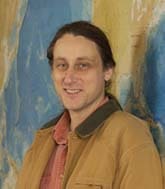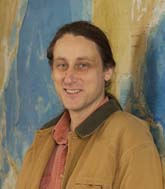WHOI Scientist To Receive Nansen Medal from European Geophysical Society
 Kurt Polzin (Tom Kleindinst, WHOI)
Kurt Polzin (Tom Kleindinst, WHOI) March 27, 2003
Kurt Polzin, an associate scientist in the Department of Physical Oceanography at Woods Hole Oceanographic Institution, will receive the European Geophysical Society’s Fridtjof Nansen Medal in recognition of his pioneering contributions to the measurement of mixing in the deep ocean. The award will be presented at the group’s annual meeting in Nice, France, in early April.
The medal, one of the society’s highest honors, was established by the EGS’s Section on Oceans and Atmosphere in recognition of the scientific achievements of Norwegian scientist and explorer Fridtjof Nansen and is awarded for distinguished research in oceanography.
Polzin was cited for his work during the World Ocean Circulation Experiment in the 1990s and studies of the mixing of Antarctic Bottom water as it crosses the Mid-Atlantic Ridge through the Romanche Fracture Zone in the South Atlantic. The fracture zone, the largest transform fault on the Mid-Atlantic Ridge, cuts across the Ridge with an offset of more than 950 kilometers (600 miles. It stretches across the South Atlantic near the Equator and reaches depths of more than seven kilometers (four miles) in some places.
The EGS award announcement noted that Polzin’s work has “stimulated a new worldwide interest in deep ocean turbulence, involving new observations of the turbulence itself, new studies of the turbulence energy sources, and new work on their implications. Variations in vertical mixing caused by turbulence can produce deep circulation gyres and may explain many of the frontal features observed in the deep ocean.”
Kurt Polzin received a B.A. degree in physics from Whitman College in 1986 and a Ph.D. degree in physical oceanography from the MIT/WHOI Joint Program in Oceanography and Applied Ocean Science and Engineering in 1992. He held positions as a postdoctoral investigator at WHOI from 1992 to 1993, and at the University of Washington from 1994 to 1996. He was appointed Assistant Scientist at WHOI in 1996, and was promoted to Associate Scientist in 1999.
His research interests include observation and modeling of energy exchanges between oceanic currents, internal waves and turbulence. This work tries to identify connections and relationships between phenomena and combines the development of theoretical constructs with the development and use of oceanographic instrumentation.
Fridtjof Nansen, the award namesake, made numerous contributions to the understanding of ocean processes through studies of the Nordic seas, including the study of internal waves and the effects of the earth’s rotation in wind induced currents. Nansen later became a champion for international justice through work for the League of Nations, receiving the Nobel Peace Prize in 1922 for these efforts. He died in 1930 at age 70.
“Its an incredible honor to receive the Nansen medal, named for such an heroic figure in European history,” Polzin says of the award. “In one lifetime he managed to be a world class athlete, a scientist, an explorer and a statesman. It’s astounding to realize that he was only 33 and on his third incarnation at the time of the Fram expedition in 1893, which discovered the Arctic Ocean. I find myself at the age of 40 being mentioned in the same sentence and feel that, somehow, I missed the starting gun. My sincerest gratitude goes to the EGS for this recognition.”
WHOI is a private, independent marine research and engineering, and higher education organization located in Falmouth, MA. Its primary mission is to understand the oceans and their interaction with the Earth as a whole, and to communicate a basic understanding of the ocean’s role in the changing global environment. Established in 1930 on a recommendation from the National Academy of Sciences, the Institution is organized into five scientific departments, interdisciplinary research institutes and a marine policy center, and conducts a joint graduate education program with the Massachusetts Institute of Technology.

